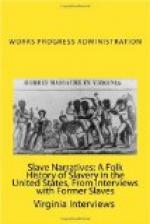My father’s family name was Andrews. How did it happen that it was not Ashley?... Oh, my dear, you have been misinformed about all slaves taking the name of the master who owned them when peace came.... No, madam. My father was named William Wallace Andrews after his father, who was an English gentleman. He had come to Missouri in early days and owned slaves.... Yes, my grandfather was white. The Ashleys brought my father to Arkansas Territory when they came. They always permitted him to keep his family name. Many other masters did the same.
From the standpoint of understanding between the white and colored races, Little Rock has always been a good place to live. The better class families did not speak of their retainers as slaves; they were called servants. Both my parents were educated by their masters. Besides being a teacher and minister my father was a carpenter and expert cabinet worker.
The first school for Negroes in Little Rock was opened in 1863 and was taught by my father. I went to school to him. A few months later there came from the north a company of missionary teachers and opened a school which I attended until 1867. My father was a minister of the Methodist Episcopal church for colored people on what is now Eighth and Broadway. He also had a chapel on the property of Mr. Ashley. You probably know that during slavery days the slaves belonged to and attended the same church as their white folks. They sat in the back, or in a balcony built for them. My father was considered the founder of Wesley Chapel, which was Methodist Episcopal. From that time until this day I have been a member of that church. Seventy-three years, I think it is. Before the break came in the Methodist church, you know, it was all the same, north and south. After the division on account of slavery the Methodist church in the south had the word “south” attached. For a long time my father did not realize that. In 1863 he and his church went back into the original Methodist church.
In 1867 the Society of Friends—we called them Quakers—came and erected a large two-story schoolhouse at Sixth and State streets. It was called Union school. When it was built it was said by the Quakers that it was to be for the use of colored children forever, but within a year or two the city bought the property and took charge of the school. As far as I can now recall, white and colored children never did attend the same school in Little Rock. There have always been separate schools for the races. I am able to remember the names of the first teachers in the Quaker school; J.H. Binford was the principal and his sister taught the primary department. Other teachers were Miss Anna Wiles (or Ware), Miss Louise Coffin, Miss Lizzie Garrison, and Sarah Henley.




